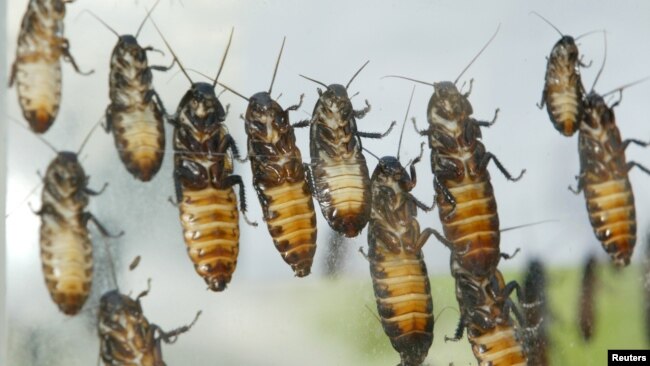昆虫の遺伝子改変に成功した新たな手法
ほとんどの昆虫に対応可能な方法と伝えています。
”害虫”と我々が認識している昆虫を無害にできるかも。
でも、疑問が!
存在意義はないのでしょうか、大きな生態系としての。
VOAで今日も英語を学びましょう!!
忘れた頃に取り上げられる遺伝子のニュースで、復習ができています🎶
ゴキブリの遺伝子を改変する新たな方法を開発(和訳)
Scientists Create New Method for Changing the Genes of Cockroaches
May 23,2022
研究者たちは、ゴキブリと呼ばれる昆虫の遺伝子に変化を与える新しい方法を開発しました。
科学者たちは、この方法は重要な一歩となり得ると述べています。あらゆる種類の昆虫の遺伝子を研究し、変化させる、つまり編集することへの障害を取り除くのに役立つと言います。
この新しい手法に使われている技術はCRISPR/Cas-9と呼ばれるものです。CRISPRは、生きた細胞のDNAの一部を加えたり取り除いたりすることで、DNAを変化させることを可能にするツールです。DNAとは、デオキシリボ核酸のことです。生物の細胞内で遺伝情報を担っている主要な物質です。
CRISPR技術は、ヒトに影響を与える遺伝的疾患の研究を行い、可能な治療法を生み出すために使用されている。2020年、CRISPR/Cas-9ツールの開発で、2人の女性がノーベル化学賞を受賞しました。
この方法は、動物や昆虫の遺伝子を標的にして変化させるのにも使われています。例えば昨年、科学者たちはCRISPR/Cas-9法を用いて、蚊が人間の標的を特定する能力を阻害したと発表しています。
今回の研究に携わった科学者たちも、CRISPR/Cas-9というツールを使っています。しかし、彼らは、多くの種類の昆虫に使用できるように研究を改善するために新しいプロセスを開発しました。
これまで、昆虫の遺伝子編集を行う研究者は、遺伝子編集された材料を発生途上の胚に直接注入していました。しかし、新しい方法では、卵がまだ成長している初期の段階で、メスの成虫に遺伝子を組み込んだ材料を注入します。
研究者らは、この新しい方法を”ダイレクトペアレント”と呼び、”シンプルで効率的”と表現しています。
日本の京都大学の大門高明氏が研究をリードし、この研究の主執筆者です。彼は、この新しい方法によって、”研究者は卵の注射の煩わしさから解放された”と声明で述べています。
大門教授は、彼のチームが発明したプロセスは、昆虫の遺伝子編集を単純化し、スピードアップさせるものであると付け加えています。「昆虫のゲノムをより自由に、自在に編集できるようになりました。原理的には、この方法は90」%以上の昆虫種で有効なはずです。」と述べています。
この成果は、最近発行されたCell Reports Methods誌に掲載されました。
研究者らによると、ゴキブリをはじめとする多くの種類の昆虫は、変わった生殖システムを持っていると言います。このため、CRISPR編集技術の適用には限界があります。ゴキブリの遺伝子を編集しようとした過去の試みは失敗しています。
研究チームは、CRISPR材料を初期胚に注入する必要のない方法を開発することで、この問題を解決したと言います。
その結果、いわゆる“knockout””ノックアウト”ゴキブリの作成に成功しました。”ノックアウト”とは、科学者が遺伝子操作によって遺伝子の全部または一部を取り除いたり、不活性化したりした生物を指す言葉です。
さらに、科学者たちはコクヌストモドキ でこの方法をテストしました。その結果、50%以上の確率で結果を出すことができたと研究チームは報告しています。
研究者らは、今回の結果は、この新しい方法が多くの種類の昆虫を対象とする研究に使えることを実証した、と述べています。しかし、ミバエのような複雑な生殖システムを持つ昆虫には、この方法は使えないと言います。
研究チームは、この方法は高価な装置や複雑な実験装置を必要とせず、高度な技術を持った実験スタッフも必要ないとしています。大門氏は、「(従来の)方法におけるこれらの問題は、多種多様な昆虫種に対してゲノム編集を行いたいと考えている研究者を悩ませてきました。」と述べています。
Scientists Create New Method for Changing the Genes of Cockroaches
Researchers have developed a new method for making changes to the genes of insects called cockroaches.
The scientists said the method could be an important step. They said it could help remove barriers to researching and changing, or editing, genes of all kinds of insects.
The technology used in the new method is called CRISPR/Cas-9. The CRISPR tool makes it possible for scientists to change DNA by adding or taking away parts of the DNA of living cells. DNA is deoxyribonucleic acid. It is a main substance that carries genetic information in the cells of living things.
CRISPR technology has been used to carry out research and create possible treatments for genetic diseases affecting humans. In 2020, two women were awarded the Nobel Prize in Chemistry for developing the CRISPR/Cas-9 tool.
The method has also been used to target and change genes in animals and insects. Last year, for example, scientists announced they had used the CRISPR/Cas-9 method to block the ability of mosquitos to identify human targets.
The scientists involved in the new study also used the CRISPR/Cas-9 tool. But they developed a new process to improve their research for use with many kinds of insects.
In the past, researchers performing gene editing on insects injected genetically edited materials directly into developing embryos. But the new method involves injecting the materials into female adults as early eggs are still developing.
The researchers call their new method “direct parental” and describe it as “simple and efficient.”
Takaaki Daimon of Japan's Kyoto University helped lead the research and was the lead writer of the study. He said in a statement that with the new method, “researchers have been freed from the annoyance of egg injections.”
Daimon added that the process his team invented simplifies and speeds up gene editing in insects. “We can now edit insect genomes more freely and at will. In principle, this method should work for more than 90 percent of insect species,” he said.
The results recently appeared in the publication Cell Reports Methods.
The researchers said cockroaches and many other kinds of insects have unusual reproductive systems. This limits the way the CRISPR editing technology can be used on them. Past attempts that sought to edit the genes of cockroaches failed.
The team said it solved the problem by creating a method that does not require CRISPR materials to be injected into early embryos.
The result successfully created so-called “knockout” cockroaches. The term “knockout” is used by scientists to describe organisms that have had all or part of a gene removed or inactivated by genetic engineering.
In addition, the scientists tested their method on red flour beetles. Those experiments produced results more than 50 percent of the time, the team reported in the study.
The researchers said their results demonstrated that the new method can be used in research involving many kinds of insects. But they noted the process will not work on some kinds of insects that have more complex reproductive systems, such as fruit flies.
The team said their method does not require costly equipment, complex experimental setups or highly skilled laboratory workers. Daimon said, “These problems with (traditional) methods have plagued researchers who wish to perform genome editing on a wide variety of insect species.”
Words in This Story
efficient – adj. working well and not wasting time or energy
annoyed – adj. angry or upset
genome – n. the complete set of genetic material of a human, animal, plant, or other living thing
principle – n. a basic idea or rule that explains or controls how something happens or works
plague – v. to cause worry, pain or difficulty to someone or something over a period of time
species – n. a group of animals or plants that are similar and can produce young animals or plants
